Retirement and Estate Planning Report for Mark and Susan Saunders
VerifiedAdded on 2021/05/31
|12
|2423
|16
Report
AI Summary
This report provides a detailed financial analysis and planning for retirement and estate, focusing on a couple's financial situation. It includes a projected cash flow statement, wealth accumulation models for superannuation, shares, and property, along with detailed assumptions. The report calculates income needs during retirement, assesses the longevity of account-based pensions, and recommends strategies to increase wealth within superannuation accounts, such as utilizing account-based pensions and self-managed super funds (SMSF). Furthermore, it addresses socially responsible investing, exploring its meaning, different approaches, and a discussion on whether it leads to lower returns. The report also reviews relevant literature and provides recommendations for the couple's financial planning needs.
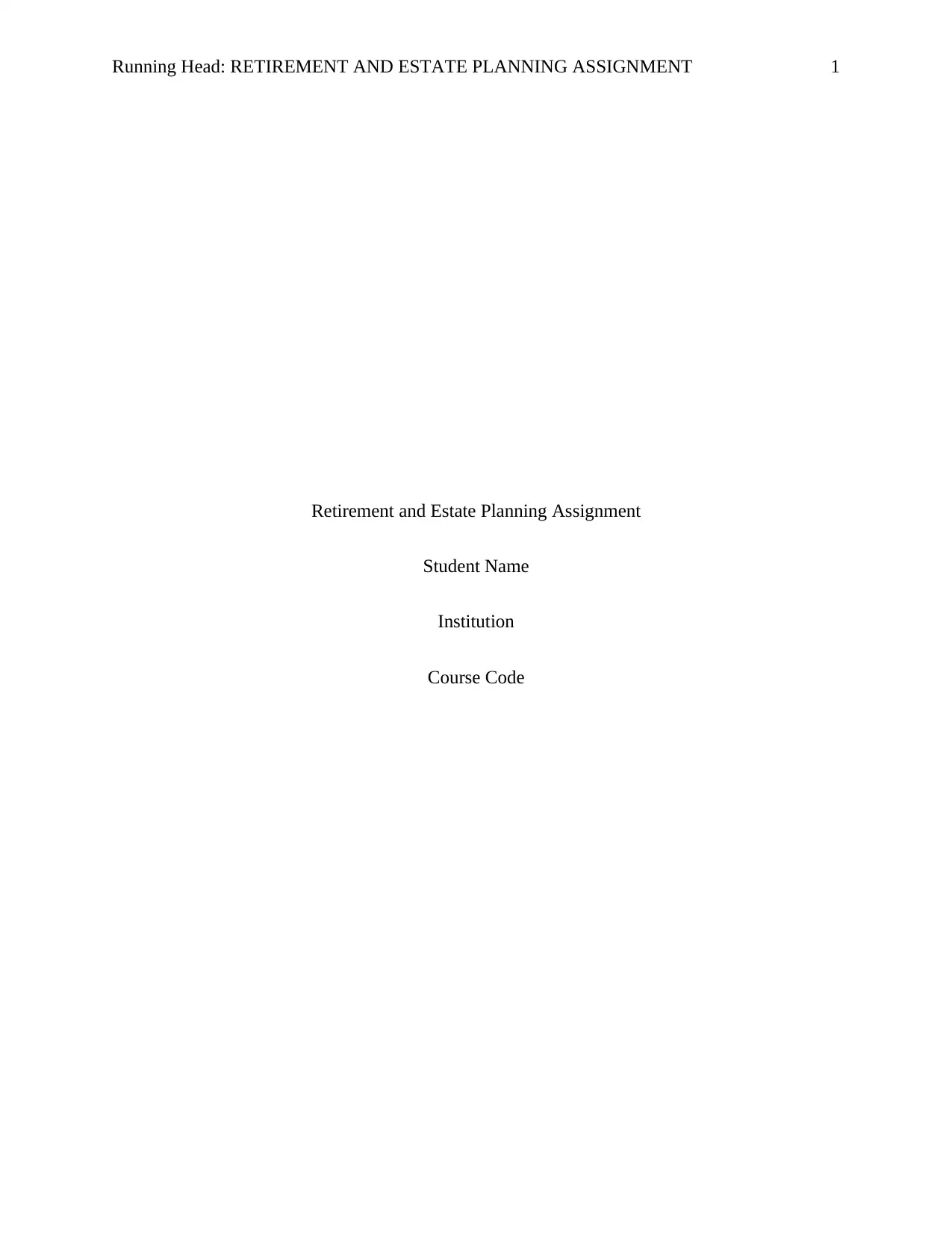
Running Head: RETIREMENT AND ESTATE PLANNING ASSIGNMENT 1
Retirement and Estate Planning Assignment
Student Name
Institution
Course Code
Retirement and Estate Planning Assignment
Student Name
Institution
Course Code
Paraphrase This Document
Need a fresh take? Get an instant paraphrase of this document with our AI Paraphraser
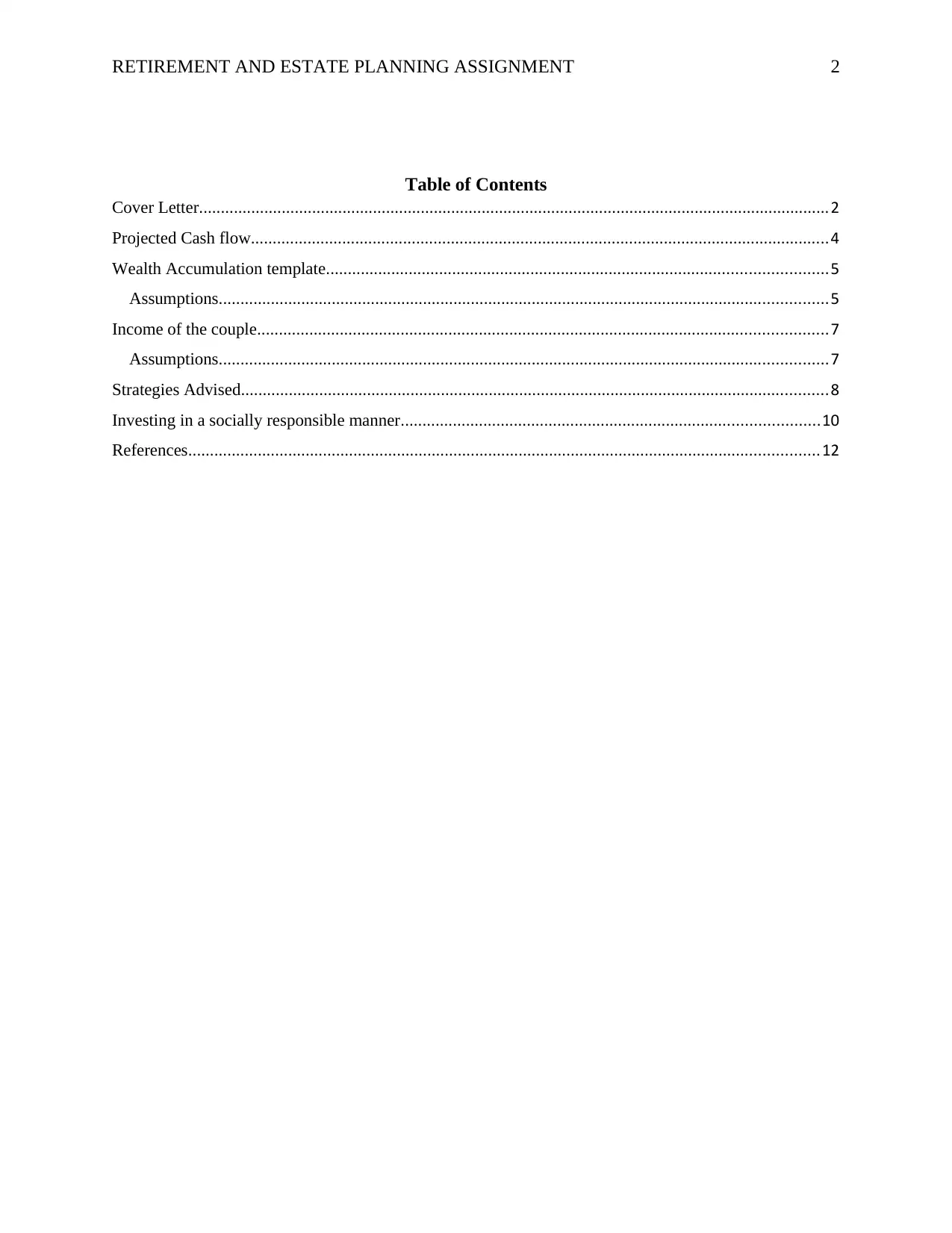
RETIREMENT AND ESTATE PLANNING ASSIGNMENT 2
Table of Contents
Cover Letter.................................................................................................................................................2
Projected Cash flow.....................................................................................................................................4
Wealth Accumulation template...................................................................................................................5
Assumptions............................................................................................................................................5
Income of the couple...................................................................................................................................7
Assumptions............................................................................................................................................7
Strategies Advised.......................................................................................................................................8
Investing in a socially responsible manner................................................................................................10
References.................................................................................................................................................12
Table of Contents
Cover Letter.................................................................................................................................................2
Projected Cash flow.....................................................................................................................................4
Wealth Accumulation template...................................................................................................................5
Assumptions............................................................................................................................................5
Income of the couple...................................................................................................................................7
Assumptions............................................................................................................................................7
Strategies Advised.......................................................................................................................................8
Investing in a socially responsible manner................................................................................................10
References.................................................................................................................................................12
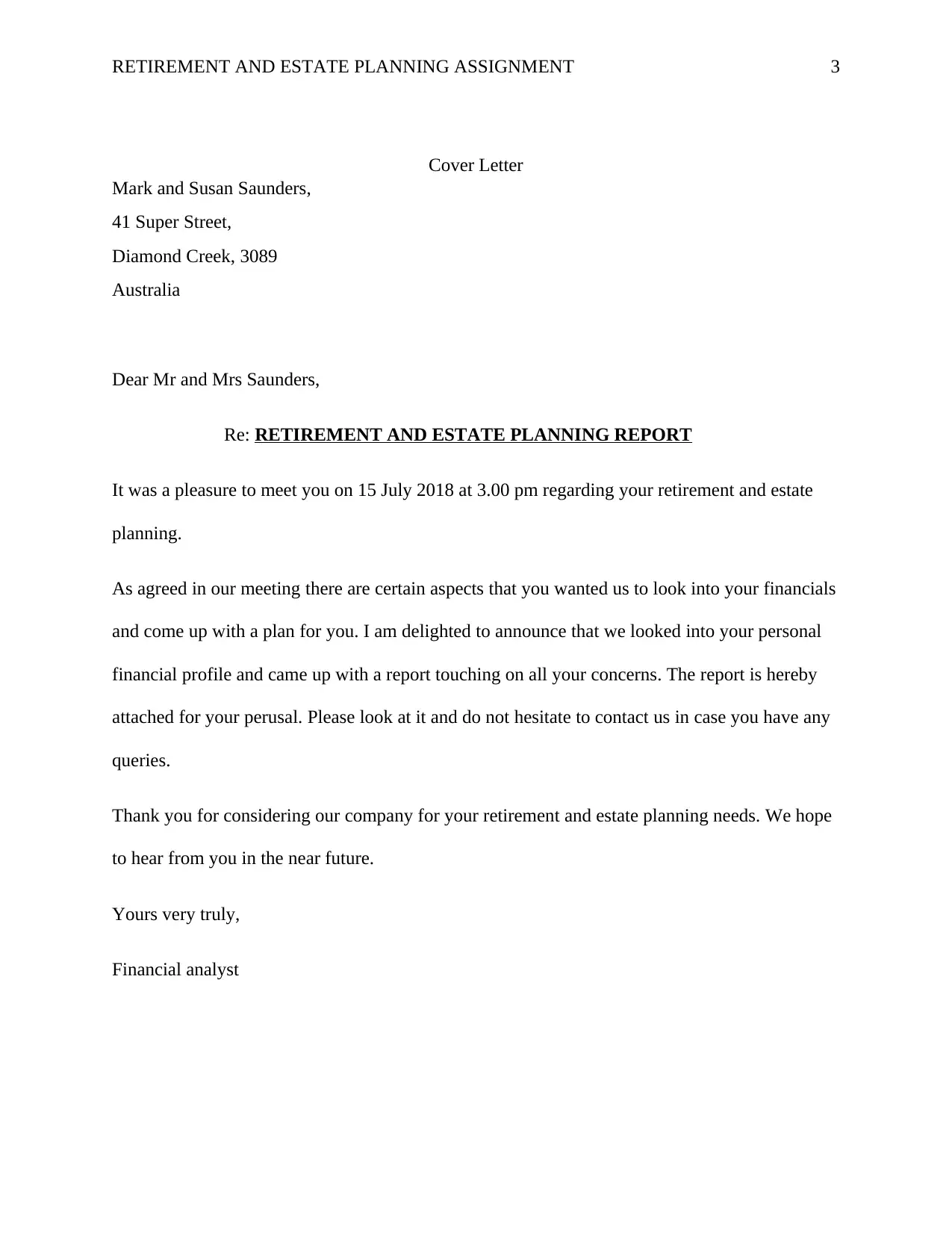
RETIREMENT AND ESTATE PLANNING ASSIGNMENT 3
Cover Letter
Mark and Susan Saunders,
41 Super Street,
Diamond Creek, 3089
Australia
Dear Mr and Mrs Saunders,
Re: RETIREMENT AND ESTATE PLANNING REPORT
It was a pleasure to meet you on 15 July 2018 at 3.00 pm regarding your retirement and estate
planning.
As agreed in our meeting there are certain aspects that you wanted us to look into your financials
and come up with a plan for you. I am delighted to announce that we looked into your personal
financial profile and came up with a report touching on all your concerns. The report is hereby
attached for your perusal. Please look at it and do not hesitate to contact us in case you have any
queries.
Thank you for considering our company for your retirement and estate planning needs. We hope
to hear from you in the near future.
Yours very truly,
Financial analyst
Cover Letter
Mark and Susan Saunders,
41 Super Street,
Diamond Creek, 3089
Australia
Dear Mr and Mrs Saunders,
Re: RETIREMENT AND ESTATE PLANNING REPORT
It was a pleasure to meet you on 15 July 2018 at 3.00 pm regarding your retirement and estate
planning.
As agreed in our meeting there are certain aspects that you wanted us to look into your financials
and come up with a plan for you. I am delighted to announce that we looked into your personal
financial profile and came up with a report touching on all your concerns. The report is hereby
attached for your perusal. Please look at it and do not hesitate to contact us in case you have any
queries.
Thank you for considering our company for your retirement and estate planning needs. We hope
to hear from you in the near future.
Yours very truly,
Financial analyst
⊘ This is a preview!⊘
Do you want full access?
Subscribe today to unlock all pages.

Trusted by 1+ million students worldwide
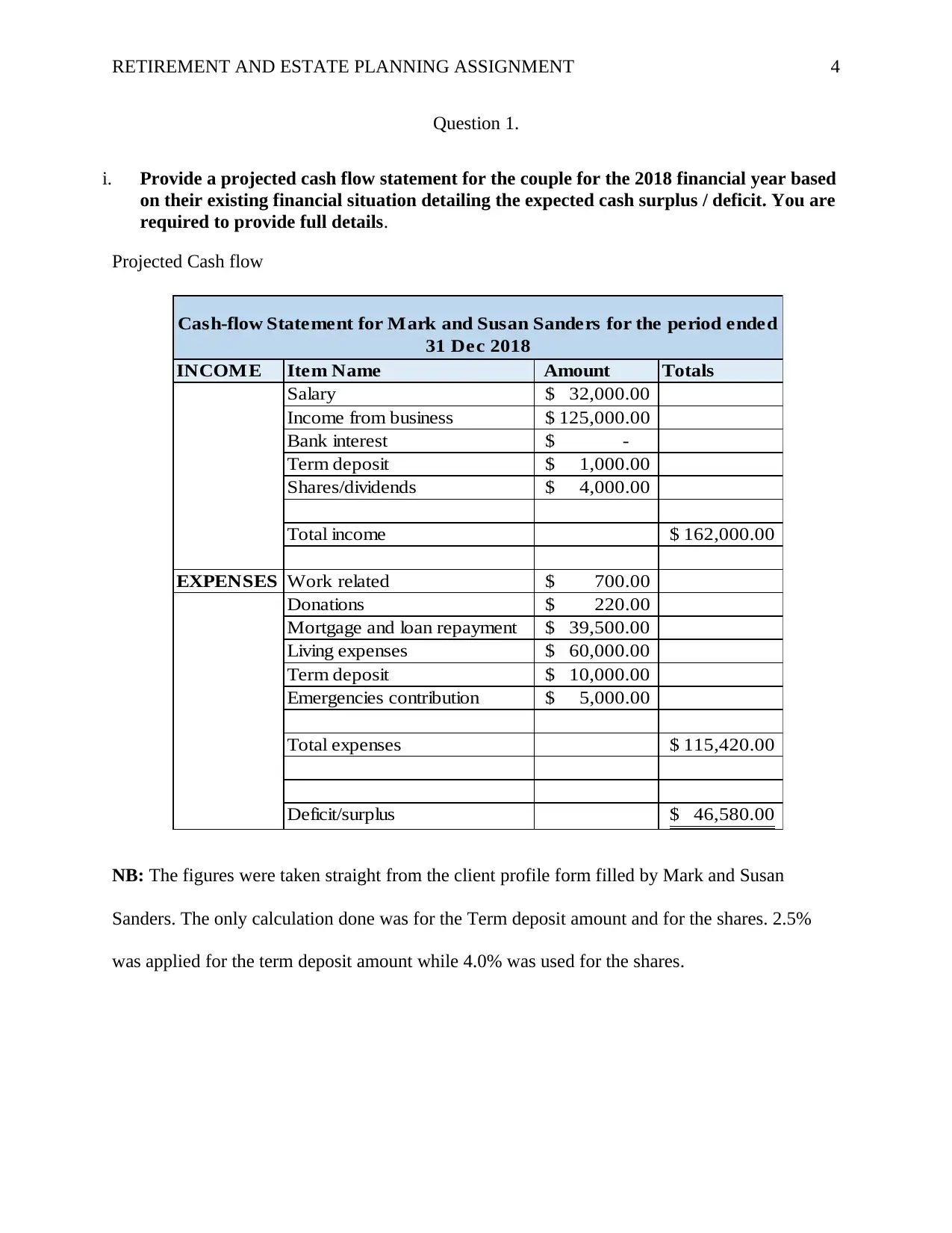
RETIREMENT AND ESTATE PLANNING ASSIGNMENT 4
Question 1.
i. Provide a projected cash flow statement for the couple for the 2018 financial year based
on their existing financial situation detailing the expected cash surplus / deficit. You are
required to provide full details.
Projected Cash flow
INCOME Item Name Amount Totals
Salary 32,000.00$
Income from business 125,000.00$
Bank interest -$
Term deposit 1,000.00$
Shares/dividends 4,000.00$
Total income 162,000.00$
EXPENSES Work related 700.00$
Donations 220.00$
Mortgage and loan repayment 39,500.00$
Living expenses 60,000.00$
Term deposit 10,000.00$
Emergencies contribution 5,000.00$
Total expenses 115,420.00$
Deficit/surplus 46,580.00$
Cash-flow Statement for Mark and Susan Sanders for the period ended
31 Dec 2018
NB: The figures were taken straight from the client profile form filled by Mark and Susan
Sanders. The only calculation done was for the Term deposit amount and for the shares. 2.5%
was applied for the term deposit amount while 4.0% was used for the shares.
Question 1.
i. Provide a projected cash flow statement for the couple for the 2018 financial year based
on their existing financial situation detailing the expected cash surplus / deficit. You are
required to provide full details.
Projected Cash flow
INCOME Item Name Amount Totals
Salary 32,000.00$
Income from business 125,000.00$
Bank interest -$
Term deposit 1,000.00$
Shares/dividends 4,000.00$
Total income 162,000.00$
EXPENSES Work related 700.00$
Donations 220.00$
Mortgage and loan repayment 39,500.00$
Living expenses 60,000.00$
Term deposit 10,000.00$
Emergencies contribution 5,000.00$
Total expenses 115,420.00$
Deficit/surplus 46,580.00$
Cash-flow Statement for Mark and Susan Sanders for the period ended
31 Dec 2018
NB: The figures were taken straight from the client profile form filled by Mark and Susan
Sanders. The only calculation done was for the Term deposit amount and for the shares. 2.5%
was applied for the term deposit amount while 4.0% was used for the shares.
Paraphrase This Document
Need a fresh take? Get an instant paraphrase of this document with our AI Paraphraser
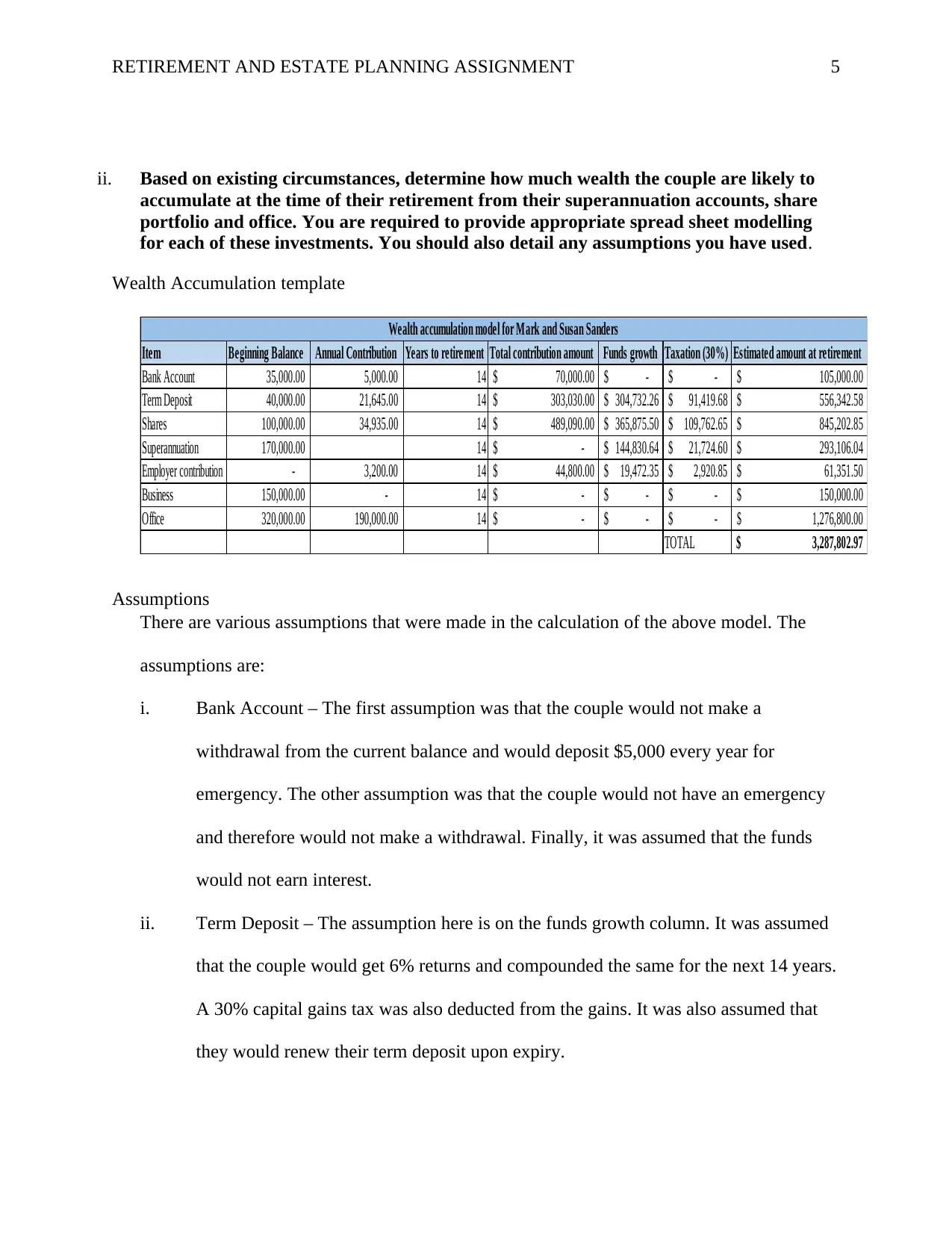
RETIREMENT AND ESTATE PLANNING ASSIGNMENT 5
ii. Based on existing circumstances, determine how much wealth the couple are likely to
accumulate at the time of their retirement from their superannuation accounts, share
portfolio and office. You are required to provide appropriate spread sheet modelling
for each of these investments. You should also detail any assumptions you have used.
Wealth Accumulation template
Item Beginning Balance Annual Contribution Years to retirement Total contribution amount Funds growth Taxation (30%) Estimated amount at retirement
Bank Account 35,000.00 5,000.00 14 70,000.00$ -$ -$ 105,000.00$
Term Deposit 40,000.00 21,645.00 14 303,030.00$ 304,732.26$ 91,419.68$ 556,342.58$
Shares 100,000.00 34,935.00 14 489,090.00$ 365,875.50$ 109,762.65$ 845,202.85$
Superannuation 170,000.00 14 -$ 144,830.64$ 21,724.60$ 293,106.04$
Employer contribution - 3,200.00 14 44,800.00$ 19,472.35$ 2,920.85$ 61,351.50$
Business 150,000.00 - 14 -$ -$ -$ 150,000.00$
Office 320,000.00 190,000.00 14 -$ -$ -$ 1,276,800.00$
TOTAL 3,287,802.97$
Wealth accumulation model for Mark and Susan Sanders
Assumptions
There are various assumptions that were made in the calculation of the above model. The
assumptions are:
i. Bank Account – The first assumption was that the couple would not make a
withdrawal from the current balance and would deposit $5,000 every year for
emergency. The other assumption was that the couple would not have an emergency
and therefore would not make a withdrawal. Finally, it was assumed that the funds
would not earn interest.
ii. Term Deposit – The assumption here is on the funds growth column. It was assumed
that the couple would get 6% returns and compounded the same for the next 14 years.
A 30% capital gains tax was also deducted from the gains. It was also assumed that
they would renew their term deposit upon expiry.
ii. Based on existing circumstances, determine how much wealth the couple are likely to
accumulate at the time of their retirement from their superannuation accounts, share
portfolio and office. You are required to provide appropriate spread sheet modelling
for each of these investments. You should also detail any assumptions you have used.
Wealth Accumulation template
Item Beginning Balance Annual Contribution Years to retirement Total contribution amount Funds growth Taxation (30%) Estimated amount at retirement
Bank Account 35,000.00 5,000.00 14 70,000.00$ -$ -$ 105,000.00$
Term Deposit 40,000.00 21,645.00 14 303,030.00$ 304,732.26$ 91,419.68$ 556,342.58$
Shares 100,000.00 34,935.00 14 489,090.00$ 365,875.50$ 109,762.65$ 845,202.85$
Superannuation 170,000.00 14 -$ 144,830.64$ 21,724.60$ 293,106.04$
Employer contribution - 3,200.00 14 44,800.00$ 19,472.35$ 2,920.85$ 61,351.50$
Business 150,000.00 - 14 -$ -$ -$ 150,000.00$
Office 320,000.00 190,000.00 14 -$ -$ -$ 1,276,800.00$
TOTAL 3,287,802.97$
Wealth accumulation model for Mark and Susan Sanders
Assumptions
There are various assumptions that were made in the calculation of the above model. The
assumptions are:
i. Bank Account – The first assumption was that the couple would not make a
withdrawal from the current balance and would deposit $5,000 every year for
emergency. The other assumption was that the couple would not have an emergency
and therefore would not make a withdrawal. Finally, it was assumed that the funds
would not earn interest.
ii. Term Deposit – The assumption here is on the funds growth column. It was assumed
that the couple would get 6% returns and compounded the same for the next 14 years.
A 30% capital gains tax was also deducted from the gains. It was also assumed that
they would renew their term deposit upon expiry.
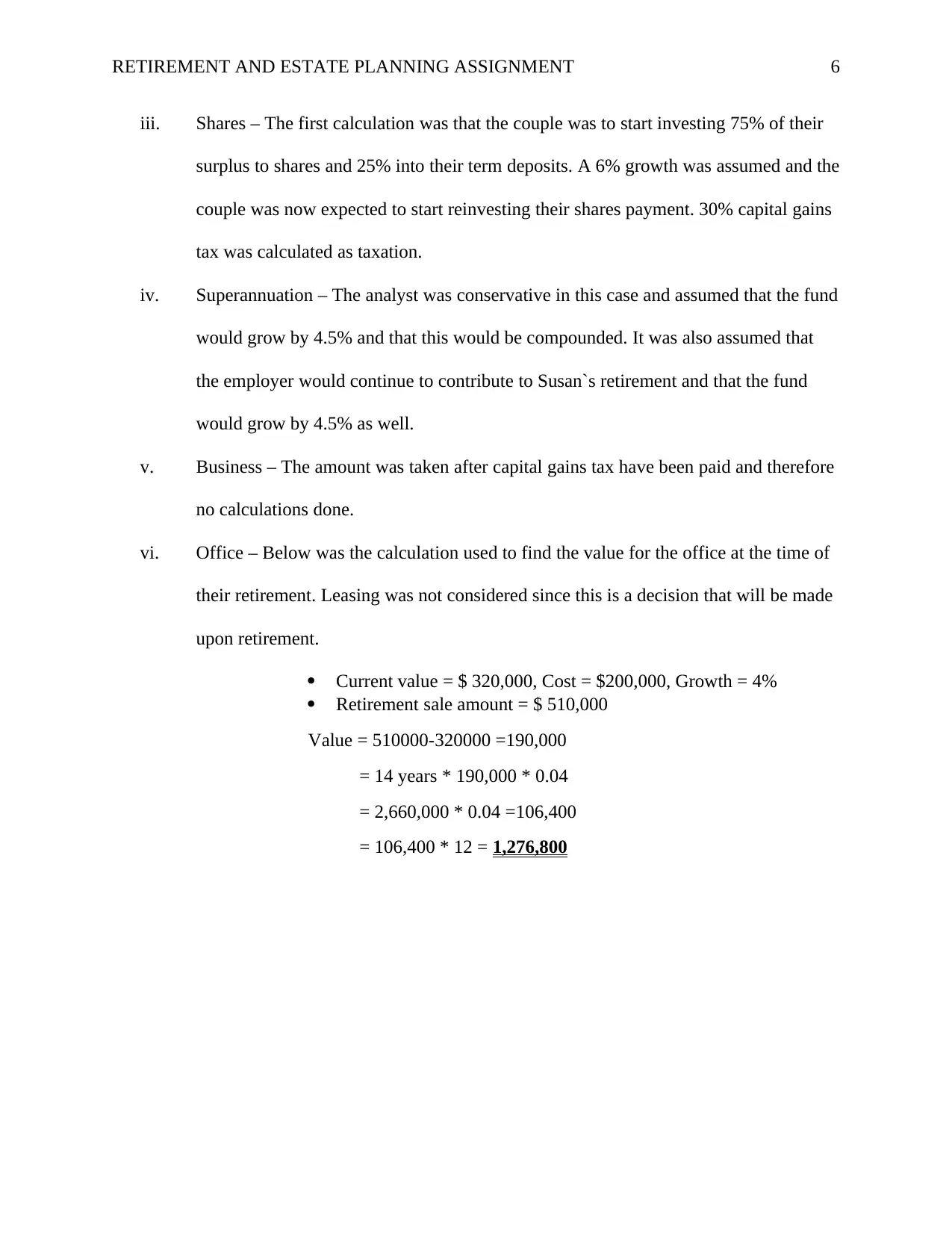
RETIREMENT AND ESTATE PLANNING ASSIGNMENT 6
iii. Shares – The first calculation was that the couple was to start investing 75% of their
surplus to shares and 25% into their term deposits. A 6% growth was assumed and the
couple was now expected to start reinvesting their shares payment. 30% capital gains
tax was calculated as taxation.
iv. Superannuation – The analyst was conservative in this case and assumed that the fund
would grow by 4.5% and that this would be compounded. It was also assumed that
the employer would continue to contribute to Susan`s retirement and that the fund
would grow by 4.5% as well.
v. Business – The amount was taken after capital gains tax have been paid and therefore
no calculations done.
vi. Office – Below was the calculation used to find the value for the office at the time of
their retirement. Leasing was not considered since this is a decision that will be made
upon retirement.
Current value = $ 320,000, Cost = $200,000, Growth = 4%
Retirement sale amount = $ 510,000
Value = 510000-320000 =190,000
= 14 years * 190,000 * 0.04
= 2,660,000 * 0.04 =106,400
= 106,400 * 12 = 1,276,800
iii. Shares – The first calculation was that the couple was to start investing 75% of their
surplus to shares and 25% into their term deposits. A 6% growth was assumed and the
couple was now expected to start reinvesting their shares payment. 30% capital gains
tax was calculated as taxation.
iv. Superannuation – The analyst was conservative in this case and assumed that the fund
would grow by 4.5% and that this would be compounded. It was also assumed that
the employer would continue to contribute to Susan`s retirement and that the fund
would grow by 4.5% as well.
v. Business – The amount was taken after capital gains tax have been paid and therefore
no calculations done.
vi. Office – Below was the calculation used to find the value for the office at the time of
their retirement. Leasing was not considered since this is a decision that will be made
upon retirement.
Current value = $ 320,000, Cost = $200,000, Growth = 4%
Retirement sale amount = $ 510,000
Value = 510000-320000 =190,000
= 14 years * 190,000 * 0.04
= 2,660,000 * 0.04 =106,400
= 106,400 * 12 = 1,276,800
⊘ This is a preview!⊘
Do you want full access?
Subscribe today to unlock all pages.

Trusted by 1+ million students worldwide
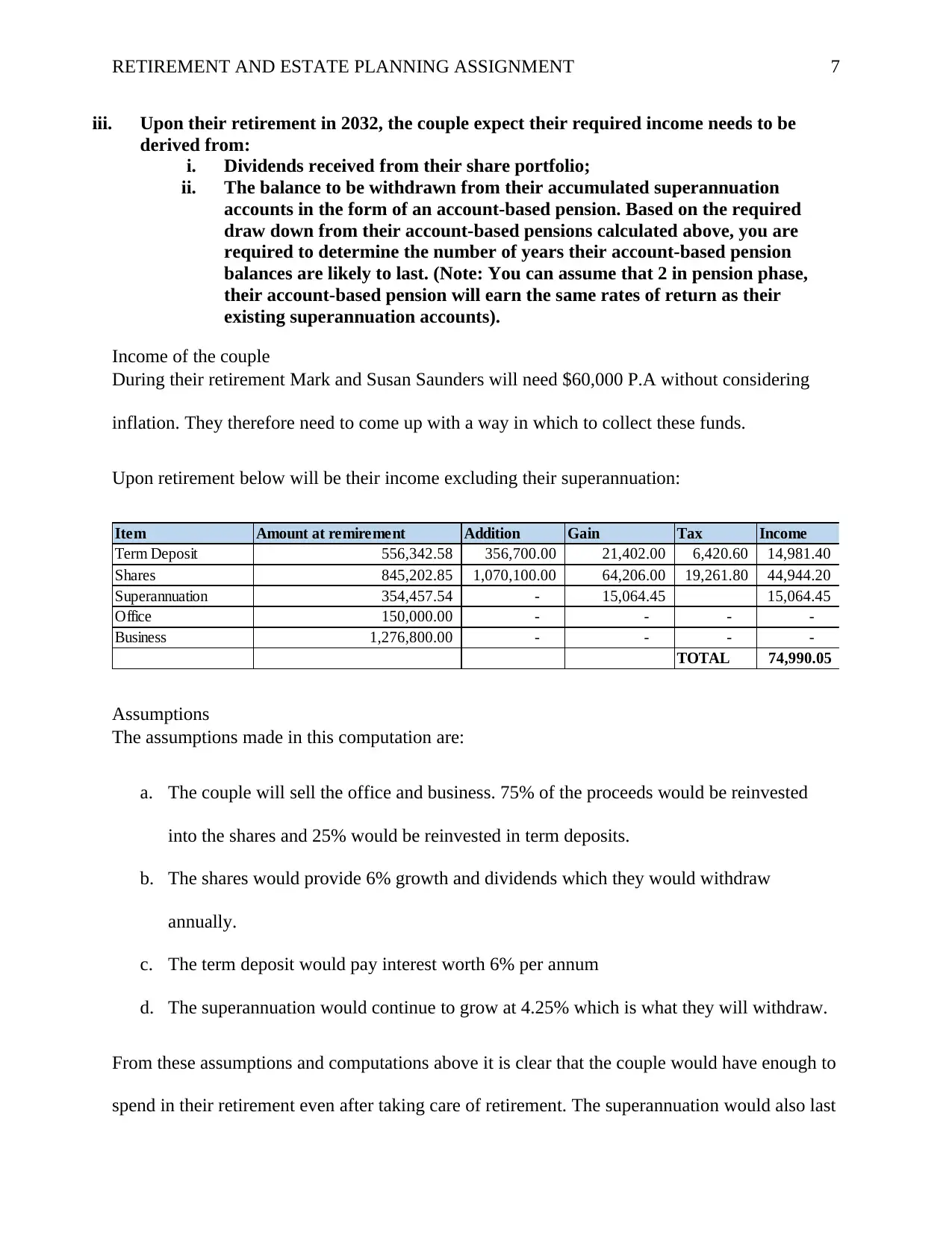
RETIREMENT AND ESTATE PLANNING ASSIGNMENT 7
iii. Upon their retirement in 2032, the couple expect their required income needs to be
derived from:
i. Dividends received from their share portfolio;
ii. The balance to be withdrawn from their accumulated superannuation
accounts in the form of an account-based pension. Based on the required
draw down from their account-based pensions calculated above, you are
required to determine the number of years their account-based pension
balances are likely to last. (Note: You can assume that 2 in pension phase,
their account-based pension will earn the same rates of return as their
existing superannuation accounts).
Income of the couple
During their retirement Mark and Susan Saunders will need $60,000 P.A without considering
inflation. They therefore need to come up with a way in which to collect these funds.
Upon retirement below will be their income excluding their superannuation:
Item Amount at remirement Addition Gain Tax Income
Term Deposit 556,342.58 356,700.00 21,402.00 6,420.60 14,981.40
Shares 845,202.85 1,070,100.00 64,206.00 19,261.80 44,944.20
Superannuation 354,457.54 - 15,064.45 15,064.45
Office 150,000.00 - - - -
Business 1,276,800.00 - - - -
TOTAL 74,990.05
Assumptions
The assumptions made in this computation are:
a. The couple will sell the office and business. 75% of the proceeds would be reinvested
into the shares and 25% would be reinvested in term deposits.
b. The shares would provide 6% growth and dividends which they would withdraw
annually.
c. The term deposit would pay interest worth 6% per annum
d. The superannuation would continue to grow at 4.25% which is what they will withdraw.
From these assumptions and computations above it is clear that the couple would have enough to
spend in their retirement even after taking care of retirement. The superannuation would also last
iii. Upon their retirement in 2032, the couple expect their required income needs to be
derived from:
i. Dividends received from their share portfolio;
ii. The balance to be withdrawn from their accumulated superannuation
accounts in the form of an account-based pension. Based on the required
draw down from their account-based pensions calculated above, you are
required to determine the number of years their account-based pension
balances are likely to last. (Note: You can assume that 2 in pension phase,
their account-based pension will earn the same rates of return as their
existing superannuation accounts).
Income of the couple
During their retirement Mark and Susan Saunders will need $60,000 P.A without considering
inflation. They therefore need to come up with a way in which to collect these funds.
Upon retirement below will be their income excluding their superannuation:
Item Amount at remirement Addition Gain Tax Income
Term Deposit 556,342.58 356,700.00 21,402.00 6,420.60 14,981.40
Shares 845,202.85 1,070,100.00 64,206.00 19,261.80 44,944.20
Superannuation 354,457.54 - 15,064.45 15,064.45
Office 150,000.00 - - - -
Business 1,276,800.00 - - - -
TOTAL 74,990.05
Assumptions
The assumptions made in this computation are:
a. The couple will sell the office and business. 75% of the proceeds would be reinvested
into the shares and 25% would be reinvested in term deposits.
b. The shares would provide 6% growth and dividends which they would withdraw
annually.
c. The term deposit would pay interest worth 6% per annum
d. The superannuation would continue to grow at 4.25% which is what they will withdraw.
From these assumptions and computations above it is clear that the couple would have enough to
spend in their retirement even after taking care of retirement. The superannuation would also last
Paraphrase This Document
Need a fresh take? Get an instant paraphrase of this document with our AI Paraphraser
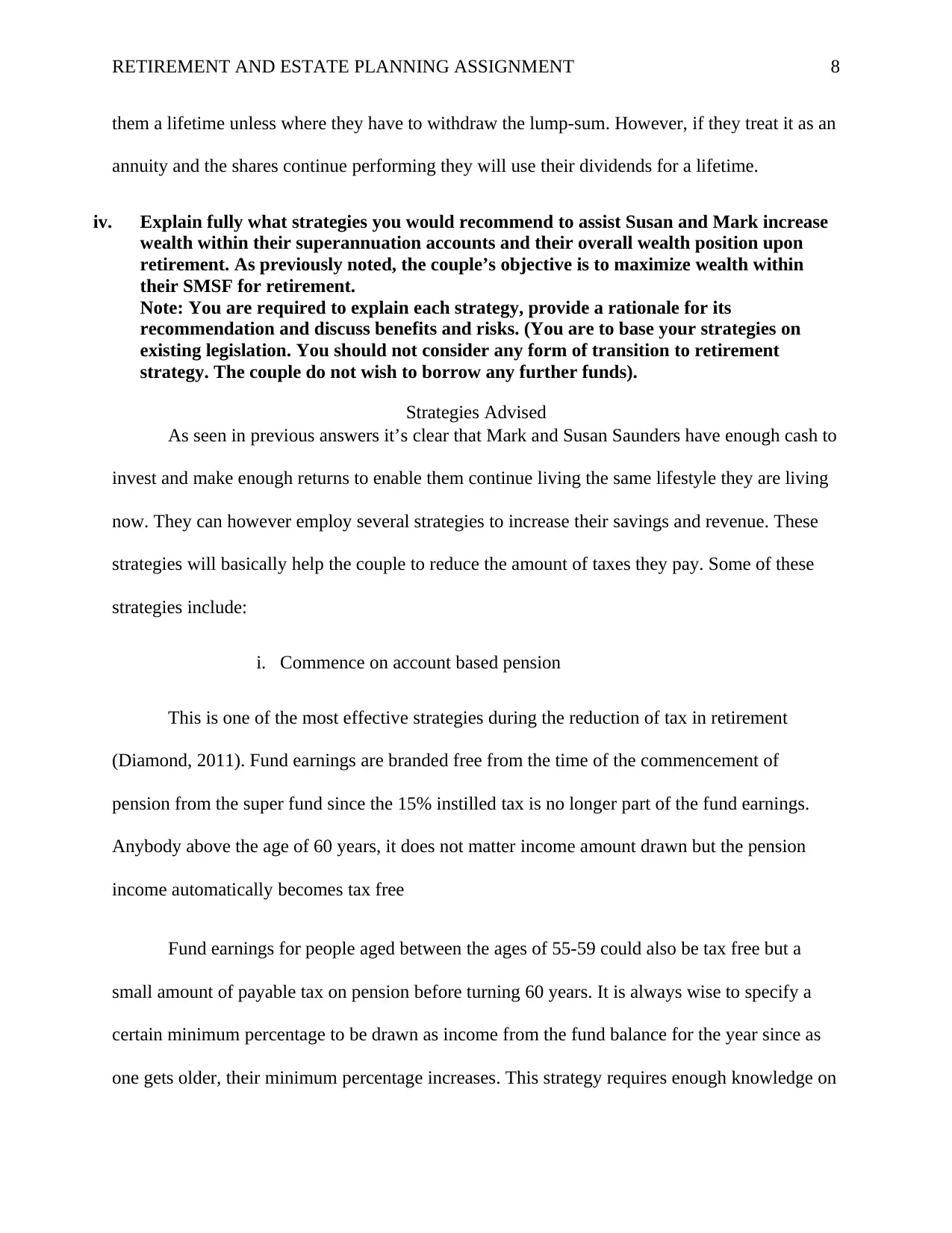
RETIREMENT AND ESTATE PLANNING ASSIGNMENT 8
them a lifetime unless where they have to withdraw the lump-sum. However, if they treat it as an
annuity and the shares continue performing they will use their dividends for a lifetime.
iv. Explain fully what strategies you would recommend to assist Susan and Mark increase
wealth within their superannuation accounts and their overall wealth position upon
retirement. As previously noted, the couple’s objective is to maximize wealth within
their SMSF for retirement.
Note: You are required to explain each strategy, provide a rationale for its
recommendation and discuss benefits and risks. (You are to base your strategies on
existing legislation. You should not consider any form of transition to retirement
strategy. The couple do not wish to borrow any further funds).
Strategies Advised
As seen in previous answers it’s clear that Mark and Susan Saunders have enough cash to
invest and make enough returns to enable them continue living the same lifestyle they are living
now. They can however employ several strategies to increase their savings and revenue. These
strategies will basically help the couple to reduce the amount of taxes they pay. Some of these
strategies include:
i. Commence on account based pension
This is one of the most effective strategies during the reduction of tax in retirement
(Diamond, 2011). Fund earnings are branded free from the time of the commencement of
pension from the super fund since the 15% instilled tax is no longer part of the fund earnings.
Anybody above the age of 60 years, it does not matter income amount drawn but the pension
income automatically becomes tax free
Fund earnings for people aged between the ages of 55-59 could also be tax free but a
small amount of payable tax on pension before turning 60 years. It is always wise to specify a
certain minimum percentage to be drawn as income from the fund balance for the year since as
one gets older, their minimum percentage increases. This strategy requires enough knowledge on
them a lifetime unless where they have to withdraw the lump-sum. However, if they treat it as an
annuity and the shares continue performing they will use their dividends for a lifetime.
iv. Explain fully what strategies you would recommend to assist Susan and Mark increase
wealth within their superannuation accounts and their overall wealth position upon
retirement. As previously noted, the couple’s objective is to maximize wealth within
their SMSF for retirement.
Note: You are required to explain each strategy, provide a rationale for its
recommendation and discuss benefits and risks. (You are to base your strategies on
existing legislation. You should not consider any form of transition to retirement
strategy. The couple do not wish to borrow any further funds).
Strategies Advised
As seen in previous answers it’s clear that Mark and Susan Saunders have enough cash to
invest and make enough returns to enable them continue living the same lifestyle they are living
now. They can however employ several strategies to increase their savings and revenue. These
strategies will basically help the couple to reduce the amount of taxes they pay. Some of these
strategies include:
i. Commence on account based pension
This is one of the most effective strategies during the reduction of tax in retirement
(Diamond, 2011). Fund earnings are branded free from the time of the commencement of
pension from the super fund since the 15% instilled tax is no longer part of the fund earnings.
Anybody above the age of 60 years, it does not matter income amount drawn but the pension
income automatically becomes tax free
Fund earnings for people aged between the ages of 55-59 could also be tax free but a
small amount of payable tax on pension before turning 60 years. It is always wise to specify a
certain minimum percentage to be drawn as income from the fund balance for the year since as
one gets older, their minimum percentage increases. This strategy requires enough knowledge on
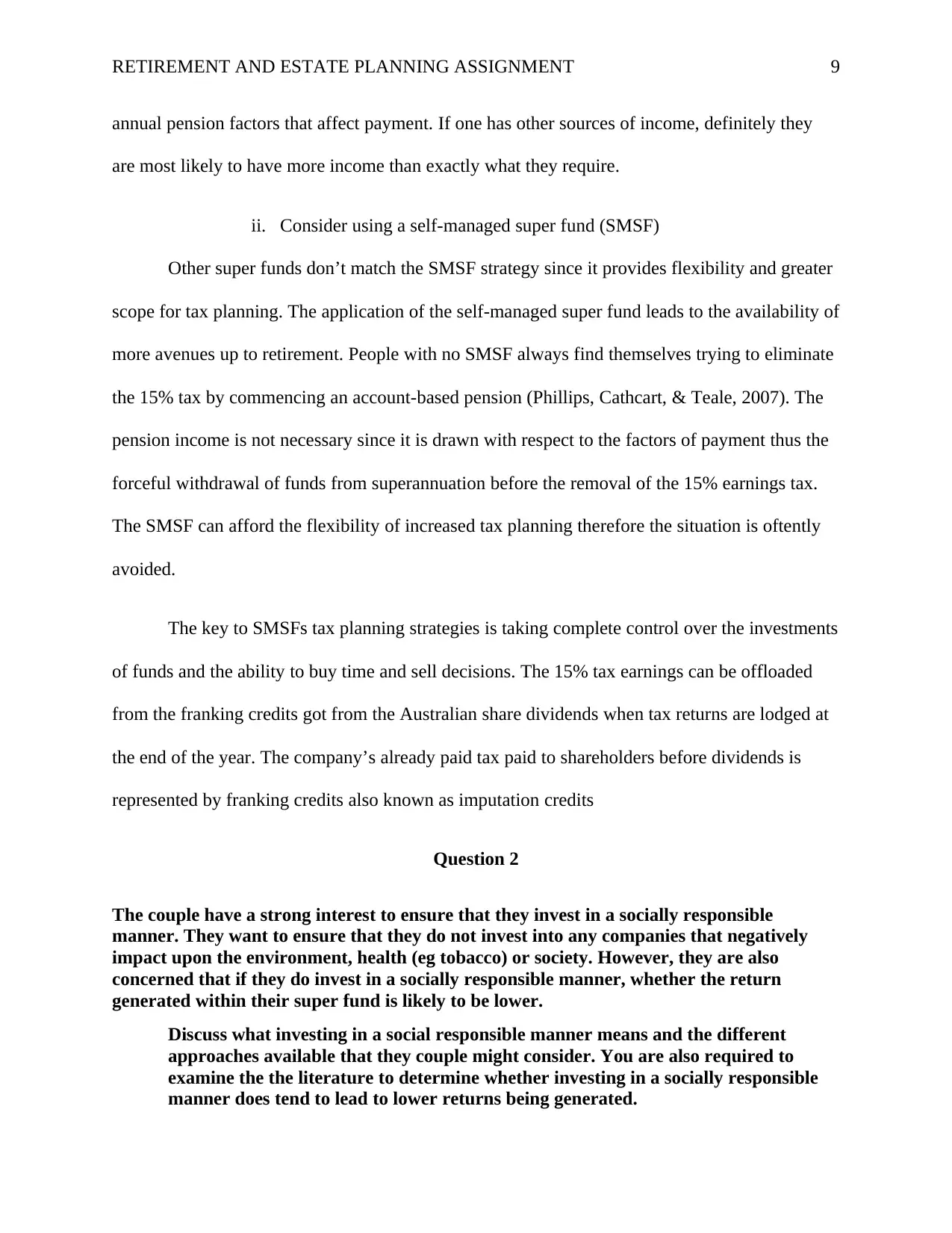
RETIREMENT AND ESTATE PLANNING ASSIGNMENT 9
annual pension factors that affect payment. If one has other sources of income, definitely they
are most likely to have more income than exactly what they require.
ii. Consider using a self-managed super fund (SMSF)
Other super funds don’t match the SMSF strategy since it provides flexibility and greater
scope for tax planning. The application of the self-managed super fund leads to the availability of
more avenues up to retirement. People with no SMSF always find themselves trying to eliminate
the 15% tax by commencing an account-based pension (Phillips, Cathcart, & Teale, 2007). The
pension income is not necessary since it is drawn with respect to the factors of payment thus the
forceful withdrawal of funds from superannuation before the removal of the 15% earnings tax.
The SMSF can afford the flexibility of increased tax planning therefore the situation is oftently
avoided.
The key to SMSFs tax planning strategies is taking complete control over the investments
of funds and the ability to buy time and sell decisions. The 15% tax earnings can be offloaded
from the franking credits got from the Australian share dividends when tax returns are lodged at
the end of the year. The company’s already paid tax paid to shareholders before dividends is
represented by franking credits also known as imputation credits
Question 2
The couple have a strong interest to ensure that they invest in a socially responsible
manner. They want to ensure that they do not invest into any companies that negatively
impact upon the environment, health (eg tobacco) or society. However, they are also
concerned that if they do invest in a socially responsible manner, whether the return
generated within their super fund is likely to be lower.
Discuss what investing in a social responsible manner means and the different
approaches available that they couple might consider. You are also required to
examine the the literature to determine whether investing in a socially responsible
manner does tend to lead to lower returns being generated.
annual pension factors that affect payment. If one has other sources of income, definitely they
are most likely to have more income than exactly what they require.
ii. Consider using a self-managed super fund (SMSF)
Other super funds don’t match the SMSF strategy since it provides flexibility and greater
scope for tax planning. The application of the self-managed super fund leads to the availability of
more avenues up to retirement. People with no SMSF always find themselves trying to eliminate
the 15% tax by commencing an account-based pension (Phillips, Cathcart, & Teale, 2007). The
pension income is not necessary since it is drawn with respect to the factors of payment thus the
forceful withdrawal of funds from superannuation before the removal of the 15% earnings tax.
The SMSF can afford the flexibility of increased tax planning therefore the situation is oftently
avoided.
The key to SMSFs tax planning strategies is taking complete control over the investments
of funds and the ability to buy time and sell decisions. The 15% tax earnings can be offloaded
from the franking credits got from the Australian share dividends when tax returns are lodged at
the end of the year. The company’s already paid tax paid to shareholders before dividends is
represented by franking credits also known as imputation credits
Question 2
The couple have a strong interest to ensure that they invest in a socially responsible
manner. They want to ensure that they do not invest into any companies that negatively
impact upon the environment, health (eg tobacco) or society. However, they are also
concerned that if they do invest in a socially responsible manner, whether the return
generated within their super fund is likely to be lower.
Discuss what investing in a social responsible manner means and the different
approaches available that they couple might consider. You are also required to
examine the the literature to determine whether investing in a socially responsible
manner does tend to lead to lower returns being generated.
⊘ This is a preview!⊘
Do you want full access?
Subscribe today to unlock all pages.

Trusted by 1+ million students worldwide
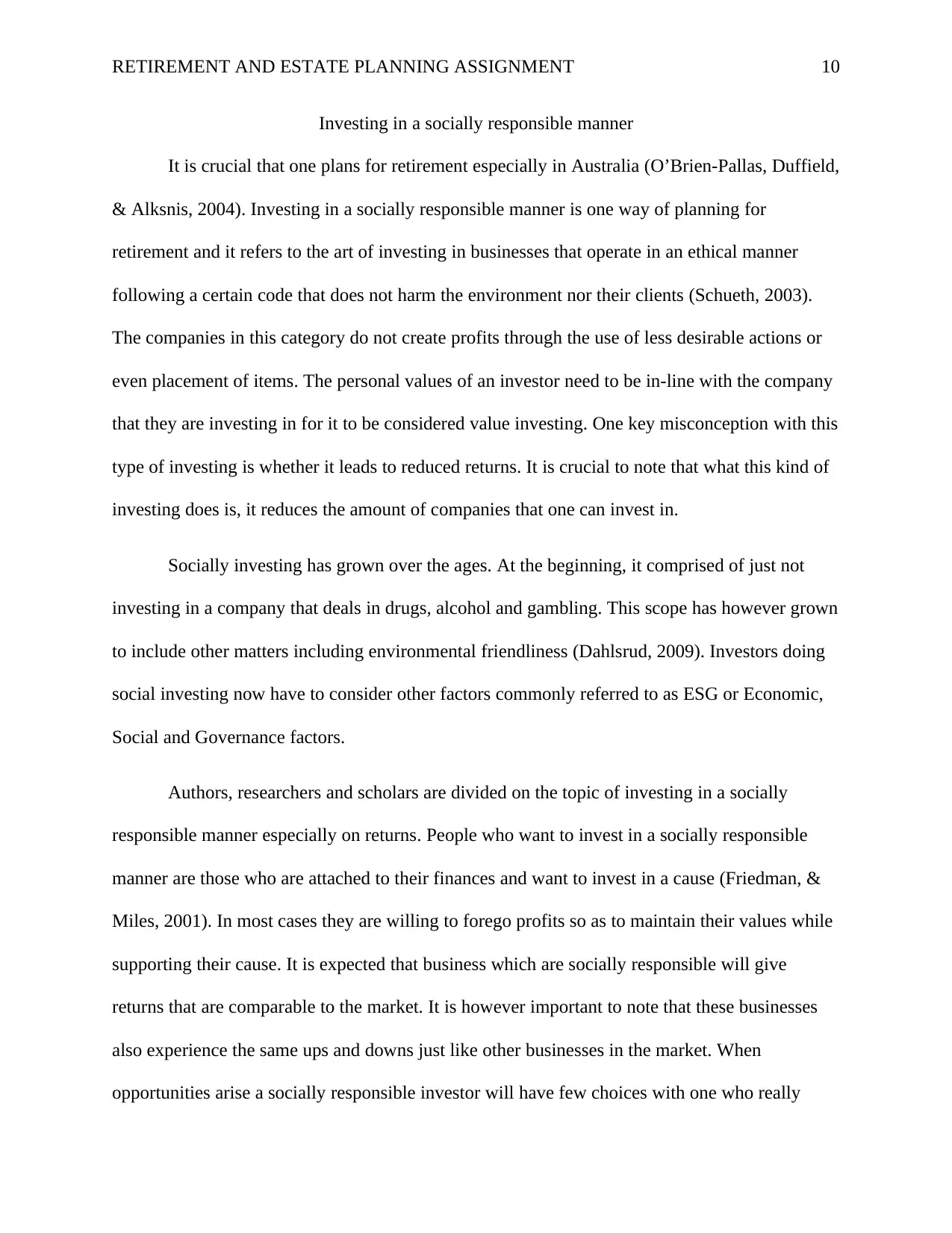
RETIREMENT AND ESTATE PLANNING ASSIGNMENT 10
Investing in a socially responsible manner
It is crucial that one plans for retirement especially in Australia (O’Brien-Pallas, Duffield,
& Alksnis, 2004). Investing in a socially responsible manner is one way of planning for
retirement and it refers to the art of investing in businesses that operate in an ethical manner
following a certain code that does not harm the environment nor their clients (Schueth, 2003).
The companies in this category do not create profits through the use of less desirable actions or
even placement of items. The personal values of an investor need to be in-line with the company
that they are investing in for it to be considered value investing. One key misconception with this
type of investing is whether it leads to reduced returns. It is crucial to note that what this kind of
investing does is, it reduces the amount of companies that one can invest in.
Socially investing has grown over the ages. At the beginning, it comprised of just not
investing in a company that deals in drugs, alcohol and gambling. This scope has however grown
to include other matters including environmental friendliness (Dahlsrud, 2009). Investors doing
social investing now have to consider other factors commonly referred to as ESG or Economic,
Social and Governance factors.
Authors, researchers and scholars are divided on the topic of investing in a socially
responsible manner especially on returns. People who want to invest in a socially responsible
manner are those who are attached to their finances and want to invest in a cause (Friedman, &
Miles, 2001). In most cases they are willing to forego profits so as to maintain their values while
supporting their cause. It is expected that business which are socially responsible will give
returns that are comparable to the market. It is however important to note that these businesses
also experience the same ups and downs just like other businesses in the market. When
opportunities arise a socially responsible investor will have few choices with one who really
Investing in a socially responsible manner
It is crucial that one plans for retirement especially in Australia (O’Brien-Pallas, Duffield,
& Alksnis, 2004). Investing in a socially responsible manner is one way of planning for
retirement and it refers to the art of investing in businesses that operate in an ethical manner
following a certain code that does not harm the environment nor their clients (Schueth, 2003).
The companies in this category do not create profits through the use of less desirable actions or
even placement of items. The personal values of an investor need to be in-line with the company
that they are investing in for it to be considered value investing. One key misconception with this
type of investing is whether it leads to reduced returns. It is crucial to note that what this kind of
investing does is, it reduces the amount of companies that one can invest in.
Socially investing has grown over the ages. At the beginning, it comprised of just not
investing in a company that deals in drugs, alcohol and gambling. This scope has however grown
to include other matters including environmental friendliness (Dahlsrud, 2009). Investors doing
social investing now have to consider other factors commonly referred to as ESG or Economic,
Social and Governance factors.
Authors, researchers and scholars are divided on the topic of investing in a socially
responsible manner especially on returns. People who want to invest in a socially responsible
manner are those who are attached to their finances and want to invest in a cause (Friedman, &
Miles, 2001). In most cases they are willing to forego profits so as to maintain their values while
supporting their cause. It is expected that business which are socially responsible will give
returns that are comparable to the market. It is however important to note that these businesses
also experience the same ups and downs just like other businesses in the market. When
opportunities arise a socially responsible investor will have few choices with one who really
Paraphrase This Document
Need a fresh take? Get an instant paraphrase of this document with our AI Paraphraser
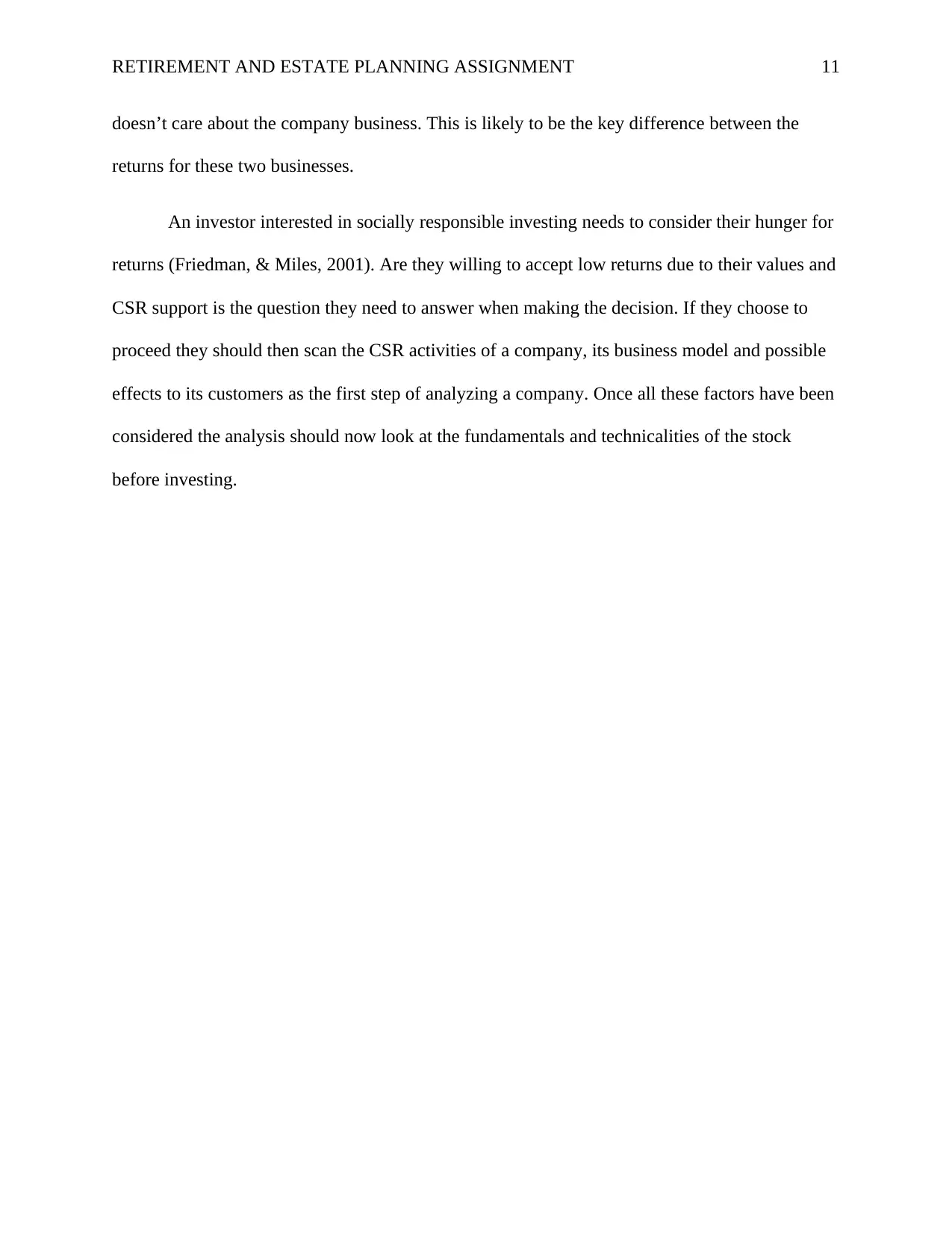
RETIREMENT AND ESTATE PLANNING ASSIGNMENT 11
doesn’t care about the company business. This is likely to be the key difference between the
returns for these two businesses.
An investor interested in socially responsible investing needs to consider their hunger for
returns (Friedman, & Miles, 2001). Are they willing to accept low returns due to their values and
CSR support is the question they need to answer when making the decision. If they choose to
proceed they should then scan the CSR activities of a company, its business model and possible
effects to its customers as the first step of analyzing a company. Once all these factors have been
considered the analysis should now look at the fundamentals and technicalities of the stock
before investing.
doesn’t care about the company business. This is likely to be the key difference between the
returns for these two businesses.
An investor interested in socially responsible investing needs to consider their hunger for
returns (Friedman, & Miles, 2001). Are they willing to accept low returns due to their values and
CSR support is the question they need to answer when making the decision. If they choose to
proceed they should then scan the CSR activities of a company, its business model and possible
effects to its customers as the first step of analyzing a company. Once all these factors have been
considered the analysis should now look at the fundamentals and technicalities of the stock
before investing.
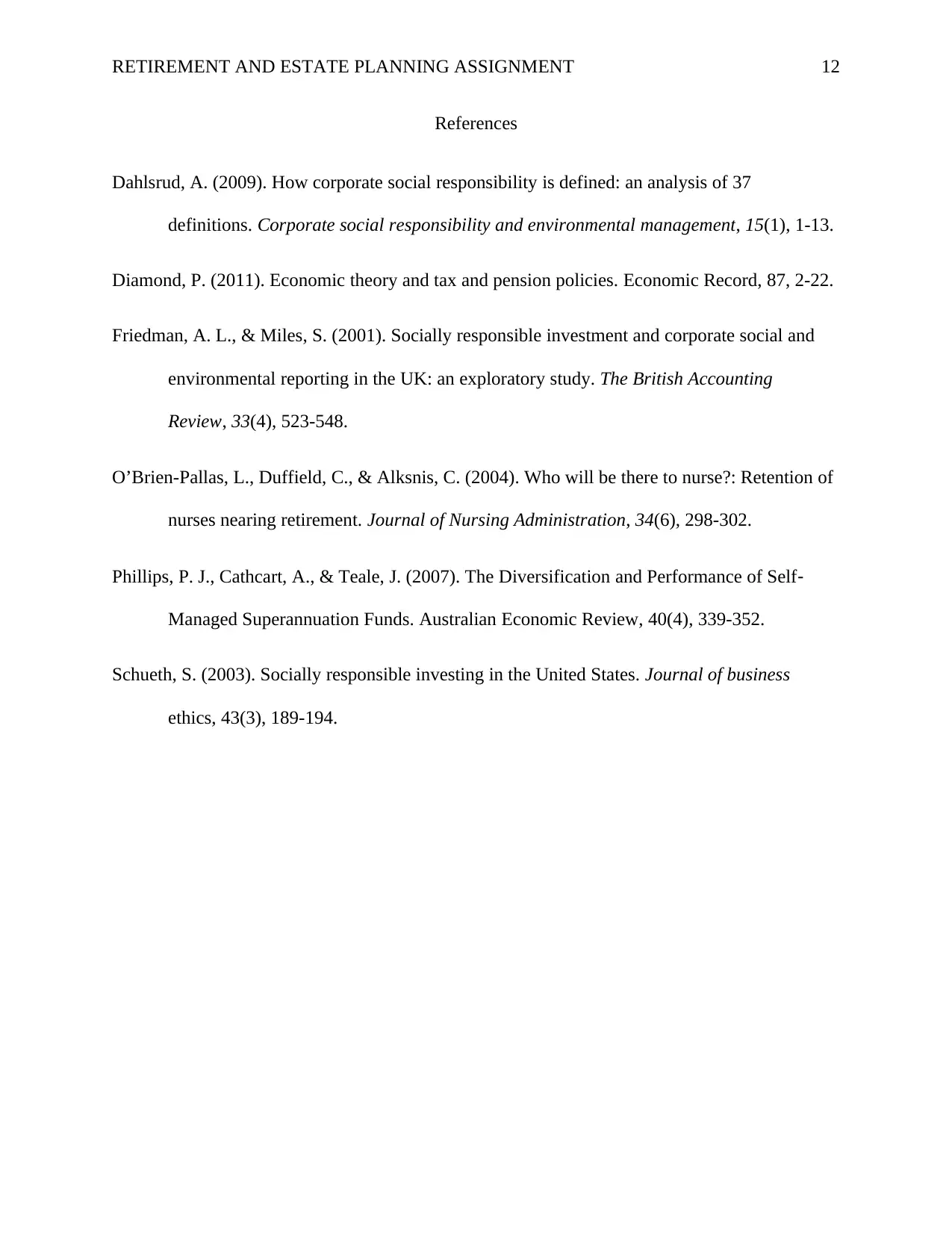
RETIREMENT AND ESTATE PLANNING ASSIGNMENT 12
References
Dahlsrud, A. (2009). How corporate social responsibility is defined: an analysis of 37
definitions. Corporate social responsibility and environmental management, 15(1), 1-13.
Diamond, P. (2011). Economic theory and tax and pension policies. Economic Record, 87, 2-22.
Friedman, A. L., & Miles, S. (2001). Socially responsible investment and corporate social and
environmental reporting in the UK: an exploratory study. The British Accounting
Review, 33(4), 523-548.
O’Brien-Pallas, L., Duffield, C., & Alksnis, C. (2004). Who will be there to nurse?: Retention of
nurses nearing retirement. Journal of Nursing Administration, 34(6), 298-302.
Phillips, P. J., Cathcart, A., & Teale, J. (2007). The Diversification and Performance of Self‐
Managed Superannuation Funds. Australian Economic Review, 40(4), 339-352.
Schueth, S. (2003). Socially responsible investing in the United States. Journal of business
ethics, 43(3), 189-194.
References
Dahlsrud, A. (2009). How corporate social responsibility is defined: an analysis of 37
definitions. Corporate social responsibility and environmental management, 15(1), 1-13.
Diamond, P. (2011). Economic theory and tax and pension policies. Economic Record, 87, 2-22.
Friedman, A. L., & Miles, S. (2001). Socially responsible investment and corporate social and
environmental reporting in the UK: an exploratory study. The British Accounting
Review, 33(4), 523-548.
O’Brien-Pallas, L., Duffield, C., & Alksnis, C. (2004). Who will be there to nurse?: Retention of
nurses nearing retirement. Journal of Nursing Administration, 34(6), 298-302.
Phillips, P. J., Cathcart, A., & Teale, J. (2007). The Diversification and Performance of Self‐
Managed Superannuation Funds. Australian Economic Review, 40(4), 339-352.
Schueth, S. (2003). Socially responsible investing in the United States. Journal of business
ethics, 43(3), 189-194.
⊘ This is a preview!⊘
Do you want full access?
Subscribe today to unlock all pages.

Trusted by 1+ million students worldwide
1 out of 12
Related Documents
Your All-in-One AI-Powered Toolkit for Academic Success.
+13062052269
info@desklib.com
Available 24*7 on WhatsApp / Email
![[object Object]](/_next/static/media/star-bottom.7253800d.svg)
Unlock your academic potential
Copyright © 2020–2025 A2Z Services. All Rights Reserved. Developed and managed by ZUCOL.





